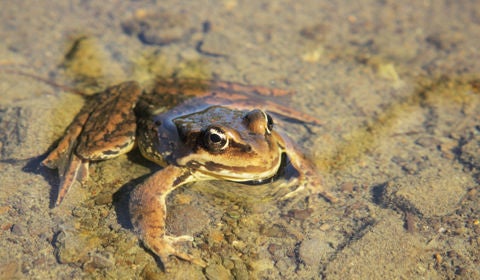Leigh Edgar

Q. I’ve heard that many reptile and amphibian species are in decline worldwide. Why?
A. By now, we all know that loss of habitat is the key threat to wildlife, affecting mammals, birds, fish and plants alike. The list of species at risk, both globally and here in Canada, continues to grow, as does the information on the causes of endangerment and the ecological consequences that follow the decline or loss of a species.
Not all canaries in the coal mine are birds. The health and status of reptile and amphibian species around the world is quickly becoming the new barometer for the health of the planet.
In Canada, we have 47 species of reptiles – 25 species of snakes, seven lizards, 11 freshwater turtles and four marine turtles. The Committee on the Status of Wildlife in Canada, the science based group that assesses the status of Canada’s wild plants and animals, has determined that 75 per cent of Canada’s reptile species are at some degree of risk. Key threats to reptiles are habitat loss, overexploitation and road kills.
Forty-six species of amphibian are found in Canada, including one mudpuppy, two newts, seven toads, 18 frogs and 18 salamanders. Amphibians are able to live much further north than reptiles; the wood frog, for example, is the only reptilian or amphibian species to live above the Arctic Circle. Globally, amphibians are more threatened than birds or mammals. Many declines are due to overexploitation and habitat loss. Alarmingly, scientists do not know the reason for the decline of nearly half of these rapidly declining species. Could it be climate change? Disease? Here in Canada, 39 per cent of our amphibian species are considered to be at some degree of risk.
While dry, scaly reptiles differ in many ways from moist, smooth amphibians, the life cycle, habitats, habits and biology of reptiles and amphibians make them vulnerable to human activity. They live in a variety of habitats, and can be found in crevices or burrows, rock piles, shrubs or trees, deserts, forests or wetlands, grasslands, in and around freshwater and under leaves. Moreover, they need different habitats for breeding, hibernating and feeding. There are many opportunities for human activities to clash with the needs of reptiles and amphibians, and clash they do.
Amphibians do not have lungs; they breathe through their skin, but can only do so if their skin in moist, so the availability of water and ponds is critical. Contamination from pesticides and other chemicals can have an especially harmful impact on amphibians. Frogs with multiple, missing or malformed legs have been observed in high numbers both in Canada and internationally. The cause is believed to be environmental pollutants, such as heavy metals and radioactive waste, which can be long lived in the environment and can even alter the sexual development of reptile and amphibian embryos. Changes to climate can cause havoc for these critters, reducing the number of insects for feeding, the water levels of ponds and the length of the breeding season. Because amphibians’ skin is so sensitive, they have been impacted by harmful UV rays, which can permeate the thinning ozone layer.
While reptiles may seem tougher than the more delicate amphibians, they fall victim to cars and are often killed while sunning themselves on the pavement or attempting to cross the road to access a water source. For reptiles, the loss of adults can quickly translate into a declining population. Many species use different habitats (both terrestrial and aquatic) at different times of the year and are vulnerable to changes in the landscape; their poor dispersal abilities, coupled with their need for an array of habitat types for different life stages, increases their vulnerability to habitat fragmentation and the construction of roads. The expansion of urban centres and the encroachment of recreational activities and industrial developments into natural areas have resulted in the loss, degradation or fragmentation of habitat, which has led to the decline of many species.
Believe it or not, a key threat to some reptile species in particular is poaching. People will often take a painted turtle home, believing they are ”saving” it, and make it their newest family pet. Turtle collection for personal or commercial reasons is directly contributing to the endangerment of some Canadian turtle species, and it is entirely preventable. Snake populations also suffer at the hands of people; many people will still kill snakes out of fear or ignorance.
Both reptiles and amphibians play key roles in the functioning of the ecosystem whether on land or in water. As both predator and prey, these animals are central to their community food webs. They eat an array of insects and rodents, in effect offering free pest control for agricultural areas. Larvae of salamanders can be significant predators in pond communities and can even influence overall biological diversity and abundance. Many small mammals, birds and other animals rely on reptiles and amphibians as part of their diet. But some overabundant predators are eating too much and impacting populations. The Lake Erie watersnake, for example, is endangered in part by predation from foxes, raccoons and even cats and dogs.
People need to pay closer attention to the fact that reptiles and amphibians are good environmental indicators. If the air, soil and water are too contaminated for natural survival and reproduction, and if their habitats are being destroyed, how can we believe that the places we live in are able to support people without issue?
So what can you do? Watch for turtles and snakes on the road from May until September. Avoid using chemicals. Plant native species in your garden. Build a pond. Keep your cat indoors. Do not bring home turtles as pets. Do everything you can to reduce your greenhouse gas emissions. Stay on the trail while hiking or snowmobiling. Remember, climate change, chemical contamination and loss of wilderness isn’t good for people either.
